by Bruce Wells | Mar 31, 2025 | This Week in Petroleum History
March 31, 1919 – Oklahoma’s Other First Oil Well –
The Cherokee-Warren Oil and Gas Company incorporated — taking over the remaining assets of the exploration venture that drilled Oklahoma’s “other first oil well” in Indian Territory. That well, drilled in 1889 but abandoned by the United States Oil and Gas Company, was on a 100,000-acre lease in the Cherokee Nation.
Edward Byrd, a Cherokee by marriage, had found oil seeps southwest of Chelsea in 1882. Two years later the Cherokee Nation authorized his United States Oil and Gas Company, “for the purpose of finding petroleum, or rock oil, and thus increasing the revenue of the Cherokee Nation.”
Learn more in Another First Oklahoma Oil Well.
April 1, 1911 – First Gusher of “Pump Jack Capital of Texas”
South of the Red River border with Oklahoma, near Electra, Texas, the Clayco Oil & Pipe Line Company’s Clayco No. 1 well launched an oil boom that would last decades. “As news of the gusher spread through town, people thought it was an April Fools joke and didn’t take it seriously until they saw for themselves the plume of black oil spewing high into the sky,” noted a local historian. (more…)
by Bruce Wells | Nov 11, 2024 | This Week in Petroleum History
November 11, 1884 – Gas Companies merge into Con Edison –
The largest U.S. gas utility company at the time was created in New York City when six gas-light companies — using manufactured coal gas — combined to form the Consolidated Gas Company. The Consolidated Edison Company, “Con Ed,” began six decades earlier as the New York Gas Light Company, which received a charter from the state legislature in 1823.

“Bird’s-eye view” illustrates New York and Brooklyn in 1873. The Brooklyn Bridge, then under construction, can be seen at the right. Image courtesy Library of Congress.
Like most early manufactured gas companies, New York Gas Light focused early efforts on public street lighting (see Illuminating Gaslight), replacing whale oil lamps installed by the city beginning in the 1760s.
Prior to the 1884 merger of the competing companies, streets often were being torn up by competing workmen installing or repairing their own company’s lines — and removing those of a rival. “Sometimes these work crews would meet on the same street and brawl, giving rise to the term “gas house gangs.”
Learn more in History of Con Edison.

November 11, 1926 – Route 66 officially commissioned
Five years after the Federal Aid Highway Act of 1921, U.S. Highway 66 was commissioned as a major thoroughfare in the national highway system. America’s “Mother Road” from Chicago to Los Angeles connected rural and urban communities along its almost 2,500 miles — until the interstate system incrementally replaced it.
Extended from Los Angeles to Santa Monica in 1935, Route 66 lost its highway status 50 years later when the American Association of State Highway and Transportation Officials officially decertified it. In 2019, Oklahoma established the Route 66 Centennial Commission, assisted by the Oklahoma Historical Society, to plan events celebrating the historic highway’s centennial in 2026.
November 12, 1899 – New York World features Mrs. Alford and her Nitro Factory
An 1899 article in the New York World profiled Mrs. Byron Alford — the “Only Woman in the World who Owns and Operates a Dynamite Factory.”
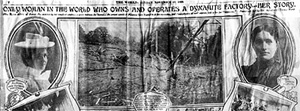
A laminated (though wrinkled) newspaper page from 1899 was part of a school project of a Mrs. Alford descendant, according to the Penn-Brad Oil Well Park and Museum in Bradford, Pennsylvania.
Mrs. Alford’s dangerous business operated on five acres outside of Bradford, Pennsylvania, with a daily production of 3,000 pounds of nitroglycerin and 6,000 pounds of dynamite. Local drillers used the explosives for “shooting” wells to boost production.
The article noted “the astute businesswoman” manufactured her volatile mixtures in 12 separate buildings, all made of wood and unpainted.
Learn more in Mrs. Alford’s Nitro Factory.
November 12, 1916 – Forest Oil Company formed
Forest Oil Company incorporated and began operations in the Bradford oilfield of northern Pennsylvania. The company, after adopting a “yellow dog” lantern logo, launched an important new technology: water-flooding (injecting water into oil-bearing formations) to stimulate production from depleted wells.
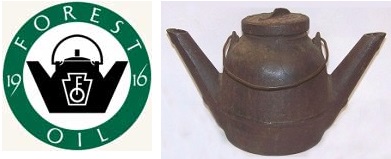
Forest Oil’s “yellow dog” lantern logo beside the oilfield lantern.
Water-flooding technology for enhanced recovery spread throughout the petroleum industry – and extended many wells’ lives by as much as a decade.
After merging in 1924 with four independent oil companies (January Oil Company, Brown Seal Oil, Andrews Petroleum, and Boyd Oil), Forest Oil was headquartered in Denver before being acquired in 2014 by a privately held Houston company.
November 12, 1999 – Plastics designated Historic Landmark
The American Chemical Society designated the discovery of a high-density polyethylene process as a National Historic Chemical Landmark in a ceremony at the Phillips Petroleum Company in Bartlesville, Oklahoma. The oil company had entered the plastics business in 1951 after discovering a catalyst for creating solid polymers.
“The plastics that resulted — crystalline polypropylene and high-density polyethylene (HDPE) — are now the core of a multibillion-dollar, global industry,” the society noted. Among the first customers for Phillips Petroleum plastics was Wham-O, which used it to make Hula Hoops and Frisbees in the 1950s.

November 13, 1943 – Death during Secret WWII Drilling Project
Derrickhand Herman Douthit of Caddo Mills, Texas, died from a fall at Well Number 148 in England’s Sherwood Forest, where he was part of a top-secret group of Americans drilling to expand production from the Eakring field. The roughnecks of Sherwood Forest increased production faster than their British counterparts while working 12-hour shifts in four crews. “Rigs shut down for one shift for his funeral, then back to work,” recalled Lewis Dugger of Louisiana. Forty-one of the volunteers returned safely in March 1944. Douthit was buried near Cambridge with full military honors.
November 14, 1927 – Gasometer Explosion shakes Pittsburgh
Three natural gas containers — gasometers — exploded in Pittsburgh, producing “tremors such as might have been caused by a severe earthquake,” according to a 1927 report, which noted the deaths of 28 people and injury of more than 400.
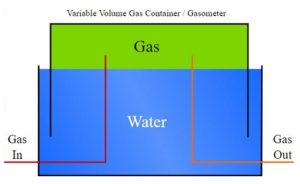
More often found in Europe, gasometers were replaced by high-pressure vessels for liquefied natural gas.
First used in the late 19th century for manufactured gas (and throughout the 20th century for natural gas), gasometers were large, cylindrical containers for storing gas at near atmospheric pressure at ambient temperatures. The volume of stored gas varied, with pressure added from the weight of a movable cap.
According to a 2006 Pittsburgh Magazine article, workmen had been using acetylene torches to repair a leak on top of a tank with a capacity of 5 million cubic feet of gas. Gasometers structures have been replaced by high-pressure vessels to store natural gas in liquid form (learn more in Horace Horton’s Spheres).
November 14, 1947 – First Oil Well drilled Out of Sight of Land
The modern offshore oil and natural gas industry began in the Gulf of Mexico with the first oil well successfully completed out of sight of land. Brown & Root Company built the experimental freestanding platform 10 miles offshore for Kerr-McGee and partners Phillips Petroleum and Stanolind. The platform, Kermac 16, was designed to withstand winds as high as 125 miles per hour.
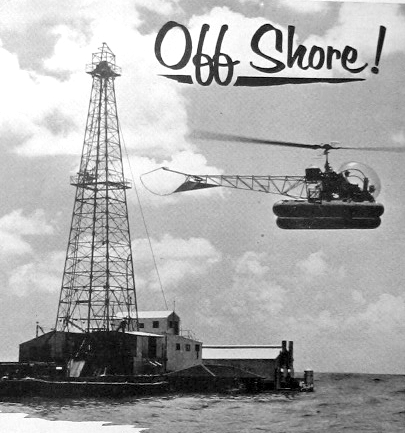
The Kermac 16 platform was featured in a 1954 Bell Helicopter advertisement encouraging use of helicopters for offshore transportation.
After investing $450,000, Kerr-McGee completed the well in about 20 feet of water off Louisiana’s gradually sloping Gulf coast. The Kermac No. 16 well initially produced 40 barrels of oil per hour.
Kerr-McGee had purchased World War II surplus utility freighters and materials to provide supplies, equipment, and crew quarters for the drilling site at Ship Shoal Block 32. Sixteen 24-inch pilings were sunk 104 feet into the ocean floor to secure a 2,700-square-foot wooden deck. The Kermac No. 16 platform withstood several 1947 hurricanes and tropical storms.
Learn more about offshore technologies in Offshore Drilling History.
November 14, 1947 – WW II “Big Inch” and “Little Big Inch” Pipelines Sold
Texas Eastern Transmission Corporation, a company established 11 months earlier to acquire the World War II surplus 24-inch “Big Inch” and 20-inch “Little Big Inch” pipelines, won ownership of them with a bid of $143,127,000. It was America’s largest sale of war surplus material to the private sector.
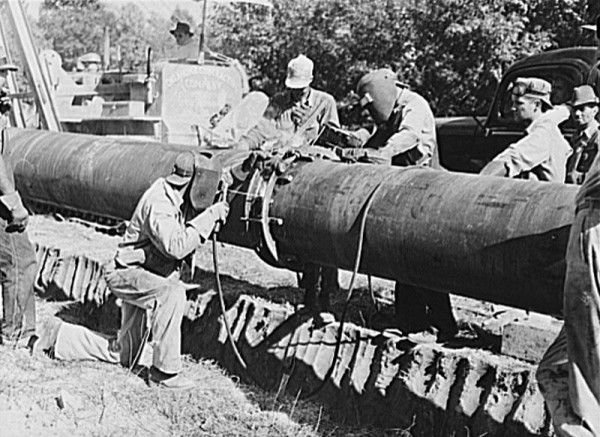
War Emergency Pipelines, Inc., in 1942 began construction of the longest U.S. petroleum pipeline construction ever undertaken in the United States — two pipelines spanning 1,200 miles. Photo Courtesy Library of Congress.
By the 1950s, Texas Eastern Transmission converted both oil product pipelines to natural gas, which was needed for the Appalachian region. By the 2000s, transmission would become bi-directional for carrying natural gas from the Marcellus and Utica shale to mid-west markets. The Big Inch Pipelines of WW II were added to the National Register of Historic Places in 1998.
November 15, 1906 – Justice Department seeks Breakup of Standard Oil
U.S. Attorney General Charles Bonaparte filed suit to compel dissolution of Standard Oil of New Jersey. Despite an 1892 court decision ordering the Standard Oil Trust to be dissolved, John D. Rockefeller reorganized it and continued to operate from New York. The Justice Department won the latest suit and Standard Oil appealed to the U.S. Supreme Court, which affirmed the lower court’s decision on May 15, 1911, and mandated dissolution of Standard Oil into 34 separate companies.

November 15, 1952 – Williston Basin produces Millionth Barrel of Oil
The Williston Basin produced its millionth barrel of oil, which came from five fields in three counties in North Dakota, where Amerada Petroleum had launched a 1951 drilling boom northeast of Williston (see First North Dakota Oil Well). By the end of 1952, the Williston Basin’s production reached 356,000 barrels of oil a month.









